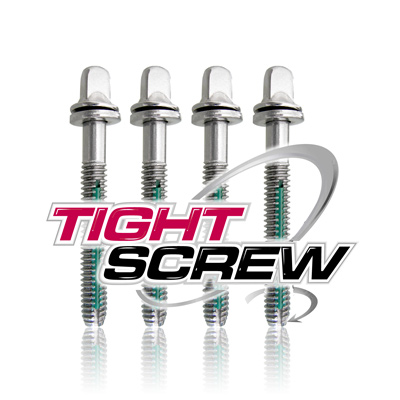
Om Tight Screws
De fleste trommeslagere kender til det problem, at deres trommeskruer løsner sig når de spiller. Især lilletrommeskruerne kan være lidt af en pestilens, og hvem har ikke prøvet at finstemme sine trommer midt under en koncert? Men løsningen ER opfundet, den er genial, og den hedder TightScrew.
Hvordan virker Tight Screws?
TightScrew er en modificeret trommeskrue. Skruen har – til forskel fra almindelige trommeskruer – indlagt et materiale på tværs af gevindet. Dette gør at frigangen i skruen er præcis så træg, at den ikke løsner sig når du spiller. Teknologien der ligger til grund for TightScrew, stammer oprindeligt fra Apachehelikopteren. Til denne havde man nemlig brug for skruer der bl.a. kunne modstå ekstreme vibrationer, og netop denne egenskab passer perfekt til trommesættet.
Fordele ved Tight Screws
TightScrew har flere fordele. For det første kan du stemme dine trommer på normal vis, uden at være begrænset til at stemme i små trin, kvarte omgange eller det der er værre. Med andre ord fungerer de som normale skruer.
Men også i ved indspilning kommer de til deres ret. Flere trommeslagere oplever nemlig, at deres trommer ændrer tonehøjde, når de indspiller. Dette kan volde problemer, hvis der skal redigeres eller bruges andre “takes” til at lappe med. Med TightScrew slipper du for denne problematik, da trommerne holder stemningen.

Tight Screws i anvendelse
TightScrew er nemme at installere. Du fjerner blot dine almindelige stemmeskruer, hvorefter du monterer de nye TightScrew trommeskruer. Efterfølgende stemmer du trommen som du plejer, dog med den lille undtagelse, at skruerne nu føles stramme helt fra start. Det er således vigtigt at du orienterer dig godt fra start. F.eks. ved at sikre dig, at alle skruer kun lige rammer reifen hele vejen rundt, inden du for alvor strammer skruerne. Hvis du vil gøre livet endnu nemmere for dig selv, kan det kraftigt anbefales at investere i en Drum Dial. Denne er en perfekt makker til dine TightScrews!
Indstil dig på flere “YES hvor sejt!!”, når du første gang har hamret løs i flere timer, og trommen stadig stemmer som da du startede med at spille…
Priser & info
TightScrew fås i flere længder, hvorfor du bør tjekke længden på dine eksisterende skruer før du suser ned til din lokale tromme-pusher. Et godt tip: Hellere købe dem lidt for lange, end lidt for korte. Producent: Tight Screw
42mm Tight Screws
Pakke med 4 stk.
Vejl. udsalg: DKK 99,00
Varekode: TIGHT 42CR-4
52mm Tight Screws
Pakke med 4 stk.
Vejl. udsalg: DKK 99,00
Varekode: TIGHT 52CR-4
65mm Tight Screws
Pakke med 4 stk.
Vejl. udsalg: DKK 119,00
Varekode: TIGHT 65CR-4
110mm Tight Screws
Pakke med 4 stk.
Vejl. udsalg: DKK 129,00
Varekode: TIGHT 110CR-4
BEMÆRK: TightScrew leveres ikke med DW/Sonor-gevind.
Anmeldelser
Flere udenlandske blade har allerede testet skruerne “positive”. Læs Modern Drummers test eller Drum!’s test via disse links.

Modern Drummer – Quick Looks
Modern Drummer, August 2005
Did you ever find yourself “playing ping-pong” in the middle of a rock gig? You know the feeling. You’re playing all-out, slamming into the pocket with sledgehammer force. As the gig progresses, your snare doesn’t sound the same as when you started. You tap the batter head near the lugs and find that most of the tension points sound like “ping,” but when you tap the spots where the rimshots land, you hear “pong.”
If you’ve been taking notes during the past few years, you know that this phenomenon is due to heavy playing momentarily reducing the pressure on those tension rods, allowing them to loosen in response to shell vibration. Various manufacturers have dealt with this problem over the years, using such things as locking nuts against the lugs or molded plastic heads that go on the rods to keep them in place. These solutions can take extra time and effort, and can interfere with fine-tuning capabilities. Carl Scott Percussion has come up with something different that does the job without the drawbacks.
What is Tight Screws?
The TightScrew is a non-loosening tension rod that is designed to stay right where you put it. It features a small channel cut along the length of the rod where the threads go into the lug. The channel is filled with something that looks like nylon, and the friction of this substance against the threads inside the lug casing keeps the rod in place. This technology is used on Apache helicopters to prevent parts from loosening under extreme vibration and temperature conditions.
To test how well the TightScrew rods worked, I replaced two rods on my snare and laid into it. The TightScrew rods stayed right in place, and I didn’t have to do any retuning during the test period. I appreciated having infinite control over my tuning, without the constraints of a device that uses a plastic edge or ball-bearing click to hold the rod in place.
Carl Scott says that if you play at light to moderate volumes, you only need to replace the rods positioned immediately under your sticks. For higher volume levels they suggest that you replace all the rods on the rim. Once this is done, you shouldn’t need to do anything until the head stretches. The rods come with a 30-day money-back guarantee, which should be plenty of time to determine if you’ll have a problem. The rods on my test snare remain where I first tuned them, and I haven’t had to touch them since.
TightScrew rods are available in three lengths: 1 5/8″ (42 mm), 2″ (52 mm), and 2 1/2″ (65 mm). I think they’re worth it; you can get tight and stay loose at the same time.
Chap Ostrander

DRUM! – Tight Screw Test
DRUM! – Maj 2006
Have you ever noticed how the tension rods in your snare’s rimshot zone loosen more quickly than other tension rods? The vibration and brief changes in head tension that occur from heavy hitting can conspire to detune a drum. It’s a common problem for strong-arm players, but even those of you who don’t hit that hard may have the same trouble if you favor die-cast hoops, tube lugs, or highly tensioned heads – all of which transfer more vibration. Now there may be a solution to all your whacking woes – TightScrews from Carl Scott Percussion.
Inspection
At first glance, they appear to be conventional, chromed-steel tension rods. On closer examination, you’ll notice that through their threads is cut a narrow slot filled with a hard nylon material. This material increases the friction and surface area between the TightScrew and the receiving nut, thus preventing detuning. Do the gizmos actually work? Absolutely. I tried them under darn-near-abusive hammering, and once my ears stopped ringing, I didn’t detect any tuning changes. Because I had to eventually give the TightScrews back, though, I wasn’t able to check how many times you can change your heads before the plastic insert loses some of its effectiveness. But I have faith.
Not just for any snares?
Some drummers may use them only on snare batters, but I think TightScrews could actually help all over your kit. Ever have a tension rod fall out from the bottom of a tom during a particularly thrashing solo? Pick up a pack of TightScrews and you never will. Unfortunately, TightScrews aren’t currently offered for Sonor or DW drums, both of which use proprietary tension-rod designs, but the good news (which we learned at press time) is that Carl Scott Percussion now offers longer versions that can replace all the rods on your bass drum.
Brad Schlueter
